Klue Compete
The Competitive Enablement Platform
Learn More
INTRODUCING KLUE INSIGHTS
FIND OUT MORE >

So you’re building out your competitive enablement program and starting with building battlecards for sales.
Your veteran sales reps are telling you they need content to help them sow fear, uncertainty and doubt (FUD) about a competitor.
Two of the most common sales tactics — and where you should focus your attention early on — are landmines and quick dismisses.
They both can seem very similar on the surface. But the devil is in the details.
We’ll break down sales landmines and the quick dismiss and show you how to best leverage them.
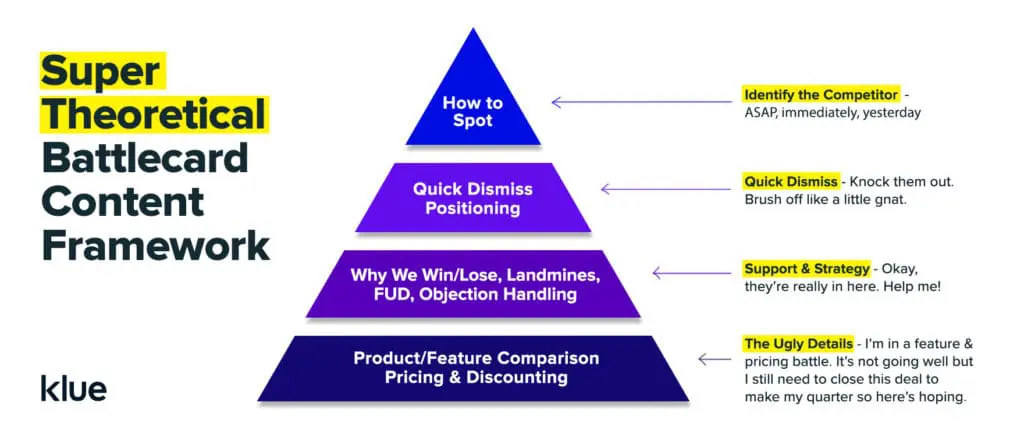

The “quick” in “quick dismiss” has two meanings:
The ultimate goal is to knock out a competitor from consideration early on with one swift talk track.
But even if you don’t knock them out in the moment, a quick dismiss can pay dividends down the road.
“Even if you can’t eliminate a competitor with a quick dismiss right away, you might still be able to put them in a small box that contributes to [your company] winning the deal in the long run,” says Jacob Gebrewold, Account Executive at Klue.
A quick dismiss is meant to throw a buyer off the scent of your competitor by acknowledging their existence, but then framing their entire business into a narrow lens that reflects positively on your business by contrast.
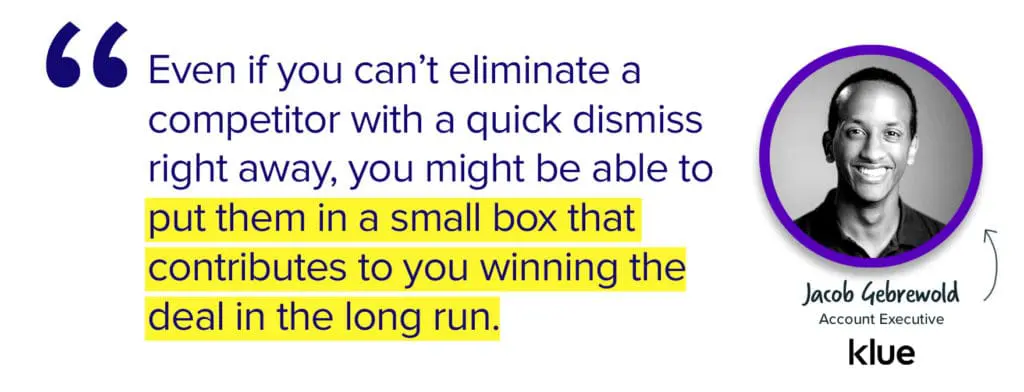

Acknowledge the competitor’s existence
Show off your expertise and knowledge of the competitive landscape by confirming this competitor is on your radar.
Sing their praises
This might sound like a counterintuitive competitive selling technique. However, every prospect expects sales reps to know what a competitor is bad at. Catch them off guard and set a positive tone for the relationship by acknowledging what they’re good at.
State their limitations
This is not a competitor love fest. Once you’ve stated the competitor’s primary strength, start to reframe the conversation back in your favour by pointing to their weaknesses.
Bring it back to your value
Now’s the time to finish off the quick dismiss by showing that although the competitor provides some value, the limitations you’ve stated are simply too great for your prospect’s needs. And the real solution lies in your product.
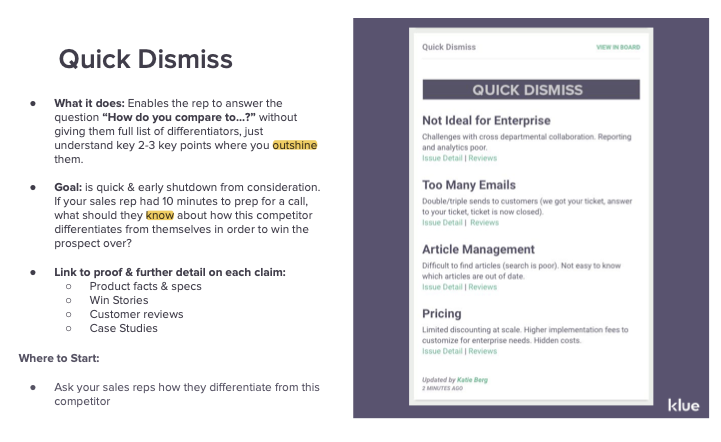

A landmine in sales almost always comes at a later stage in the buyer journey.
That’s because as opposed to a quick dismiss where the goal is to knock out competitors early, you’re likely already locked in battle with a competitor by the time you’re laying landmines.
The premise on which you base both a quick dismiss and landmine will be the same: Key competitive advantages your solution offers that your competitor can’t match.
But, in addition to timing, the key difference between a land mine and a quick dismiss is in the framing.
Landmines typically take the form of a question. A question that you want the prospect to directly ask your competitor, and or a question you want your prospect to reflect on.
Most importantly, the question is crafted in such a way that your competitor cannot effectively answer it. That’s because the question forces them to address a deficiency in their solution.
For example, let’s say your competitor lacks integration capabilities. You’ve determined that this is important to the prospect. Now it’s time to craft some open-ended questions that draw attention to it:
Q. How can I integrate my Salesforce data with your platform?
A. It’s impossible or very hard to do.
Q. How easy is it to embed and access things like Gong Calls, Gartner Reports, and documents into your platform?
A. It’s going to be a serious challenge, if at all possible.
Q. Can you share some specifics around your plans to improve your integrations this year?
A. There’s no indication of any forthcoming improvements based on their product roadmaps.
No matter how you lay a landmine, or other kinds of FUD, the need for these tactics almost always arises in competitive deals. As Klue’s Lauren Chambers puts it, “If you don’t take the opportunity to lay some landmines, just know your competitor probably did.”
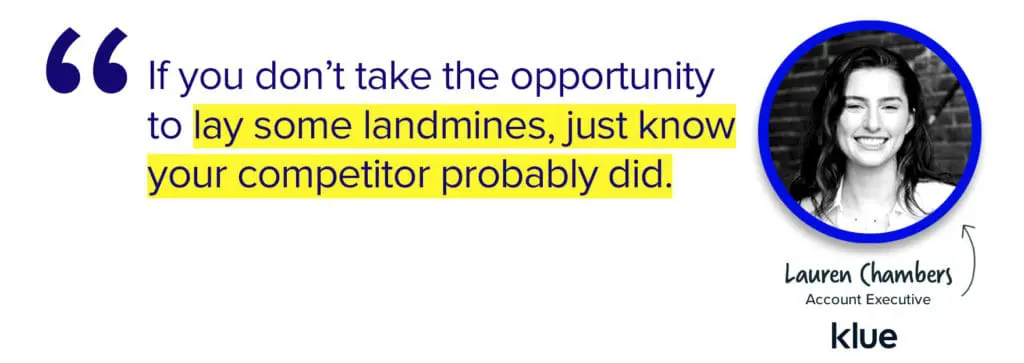

Identify limitation or weakness in competitor solution
Your reps in the field, coupled with a strong win-loss program and data, will reveal why you’re winning or losing against a competitor. Leverage this key point, your best positioning and messaging as the basis for your landmine.
Make a claim based on the limitation
This doesn’t have to be a provable beyond a reasonable doubt kind of claim. It can be more of an inference. For example, if your competitor hasn’t made any attempts to up their integration game, what does this say about their ability and desire for innovation? How adaptable will their team be? These are the kinds of questions that can sow some serious doubt in prospects’ heads.
Explain why this matters to the prospect
Don’t give your prospect an opportunity to say, ‘so what’ to your claim. Let them know why your competitor’s deficiency will have a highly negative effect for the buyer’s business. Bring it all back to the pain points you unearthed in discovery
Show proof points
Find one or two objective facts that support your arguments. Sometimes it’s as simple as pointing to a competitor’s website. Other times you’ll need to point to third-party data or reliable news sources to make your point. No matter what, you have to go beyond simply, “trust me on this one”.
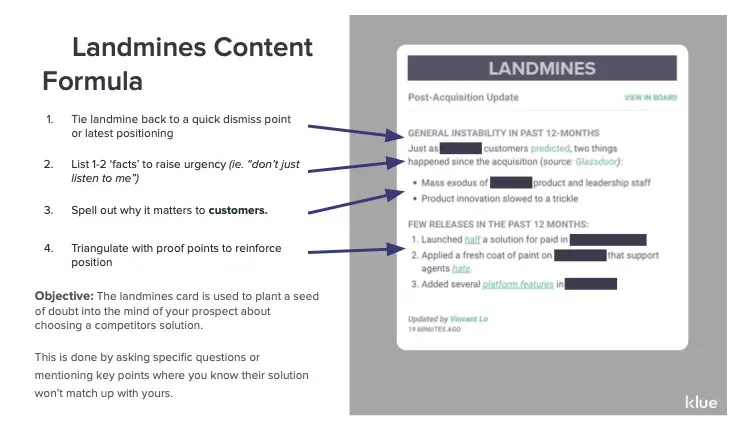

Timing
A quick dismiss comes early in the buyer journey when you can quickly deposition a competitor and knock them out of the running
A landmine comes into play when you’re locked in competition with the competitor and you need to take an active approach in booting them out of the running.
Statement versus question
A quick dismiss requires a statement acknowledging the competitor and one of their strengths, followed by highlighting a weakness and contrasting it with the value you bring
A landmine is almost always phrased in the form of a question that is meant to be posed to your competitor.
Depth
A quick dismiss doesn’t have to be a fully fleshed out argument or thought. While it needs to be based in substance and fact, a quick dismiss only penetrates a bit deeper than surface level.
A landmine digs deep. The substance is based on multiple factors: a competitor’s deficiency, the prospect’s needs, the prospect’s fears, the competitor’s inability to answer the question.
Objective
A quick dismiss is meant to knock a competitor out from consideration early on in the buyer journey before the prospect decides to narrow down their shortlist.
A landmine is meant to plant a seed of doubt in the buyer later in the consideration stage, and encourages the buyer to bring questions to your competitor to which they have no answer.
Sales landmines and the quick dismiss are tactics to help you towards your goal of crushing the competition and winning more deals. But, as we’ve shown here, the differences between the two tactics are significant.
Check out how to build Quick Dismiss, Landmine and a ton of other battlecards in our Competitive Battlecard 101 series.




Competitive Enablement
The topic of Large Language Models (LLMs) has a lot of confusion. Here's what you need to know about how Klue is working with them.


Competitive Enablement
Product Marketing
If your competitive intel game is too strong for automation, too pure for data privacy, and too rebellious for accuracy — then Klue AI is probably not for you.


Let’s do it. Tell us a bit about yourself and we’ll set up a time to wow you.
Let's do it. Tell us a bit about yourself and we'll set up a time to wow you.
XLet's do it. Tell us a bit about yourself and we'll set up a time to wow you.
XSubscribe to get our latest AI functionality and news in your inbox.
XOur Buyer Pulse feature, set to launch in Q2 2024, offers valuable insights into the factors influencing buyer decisions in your pipeline. By signing up for the waitlist, we can better gauge interest and proactively engage with you to streamline the setup and integration process before the feature becomes widely available.
X